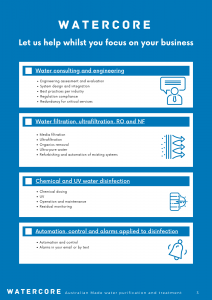Water disinfection as a critical part of commercial and industrial water applications
Water disinfection plays a major role in drinking water treatment, however it is also a critical part of commercial and industrial water applications
EDGECLIFF, NSW, AUSTRALIA, September 29, 2021 /EINPresswire.com/ -- Bacteria, viruses and protozoa are microorganisms with a relatively simple structure that are present in our environment in many forms and sizes. From their origin in ground and surface water they easily enter storage tanks and the main distribution network.In regards to size, which is an important factor from a filtration point of view, they are distributed as follows:
- Protozoa are single-cell organisms ranging in size from about 1 to 50 μm and are typically responsible for gastrointestinal diseases.
- Bacteria, also single-cell organisms, are in the size range of 0.1 to 10 μm.
- Viruses are the smallest of waterborne agents. Typically ranging in size from about 0.02 to 0.2 μm are too small to be seen with a light microscope
A number of common water contaminants, also known as substrate, are used by bacteria for growth:
- Organic compounds
- Compounds of Phosphorus, Potassium, Sulphur and Magnesium
- Metal ions such as Iron, Nickel and Cobalt
The most problematic contaminants are organic compounds, however water stagnation, scale in pipes and high ambient temperatures will also accelerate the formation of biofilm.
A comprehensive water filtration1 is mandatory before any disinfection is carried out. TSS (total suspended solids) must be 1mg/L or less, as bacteria and viruses are often attached to these small particles.
Another important consideration is that suspended solids usually obstruct the effect of disinfectants, for example interrupting light transmission in the case of UV disinfection.
In regards to organics, dissolved or in suspension this matter must be reduced as much as possible before disinfection, otherwise water will have a higher disinfectant demand and dosing will need to be higher. Organics in water also represent a risk for public health in a way that, when oxidised by Chlorine, Ozone or any other oxidising agent, can generate toxic by-products such as THMs.
Ultrafiltration2 is a type of membrane filtration with a nominal pore diameter in the range of 0.02 to 0.04 μm what makes it very effective against protozoa (LOG removal >6), bacteria (LOG removal >4) and also viruses, which are considerably smaller (LOG removal > 1).
Watercore design, manufacture and maintain a wide range of water and wastewater treatment systems for industrial and commercial applications: Iron filtration, reverse osmosis systems3, chlorination and UV disinfection, water softening etc.
Focusing on industrial and commercial projects, Watercore combines different technologies to succeed in each industry: cooling systems, boilers, irrigation water, etc. In remote communities, Watercore collaborates to supply reliable safe drinking water and upgrade of distribution systems and treatment plants.
David Garcia
Watercore
+61 411120079
email us here
Visit us on social media:
Facebook
Twitter
LinkedIn
1 https://watercore.com.au/products/turbidity-removal-sediment-filters/
2 https://watercore.com.au/products/industrial-ultrafiltration-system/
3 https://watercore.com.au/products/industrial-reverse-osmosis-desalination/

